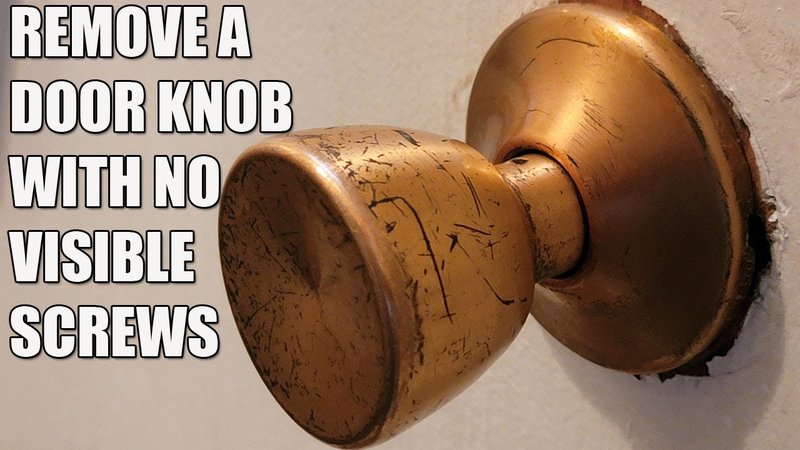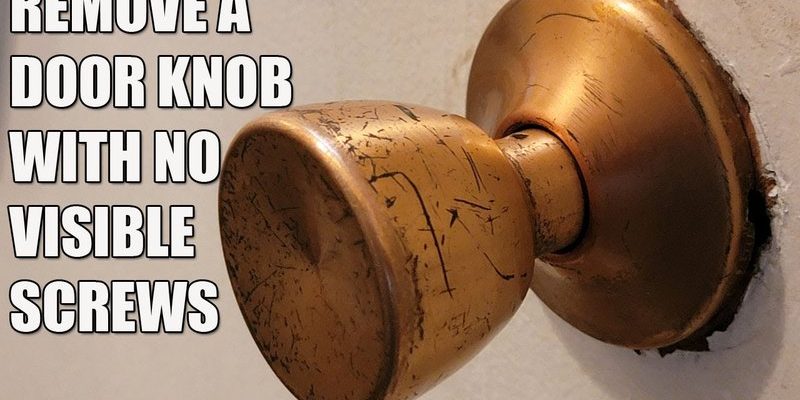
Picture it like trying to find a hidden treasure. You’ve got a treasure map (or in this case, your door knob), and all you need to do is figure out where the x marks the spot. Today, we’ll unravel the secrets behind those tricky knobs, taking you through practical methods and tools needed to get the job done. So grab a cup of coffee, and let’s dive in.
Understanding Door Knob Types
Different types of door knobs exist, and they all function a bit differently. Generally, door knobs fall into two categories: those with visible screws and those that keep their hardware a bit more undercover.
You might encounter a knob with a set screw, often located on the side or bottom of the knob itself. This means you’ll need a small Allen wrench or screwdriver to release it. On the other hand, some knobs are designed without visible screws at all. These typically feature a hidden release mechanism which requires a bit of finesse to operate. Knowing what type of knob you’re dealing with can save you a lot of guesswork and time.
Let’s delve deeper into the mechanics of these knobs. If you’re looking at a knob without screws, they often have a push-button or a pin that you need to find and manipulate. Understanding these details will help you approach the problem more effectively.
Gathering Your Tools
Before diving in, let’s gather the necessary tools. You won’t need much, but a few items will make your life easier. Here’s a quick list:
- Flathead screwdriver
- Phillips screwdriver
- Pliers
- Allen wrench (if applicable)
- Flashlight
Having the right tools on hand is crucial. For instance, a flathead screwdriver can help pry apart the knobs if they’re stubborn. Phillips screwdrivers come in handy for knobs that may have hidden screws under the faceplate. And don’t underestimate the value of good lighting—a flashlight can help you see those hard-to-reach spots where the hidden mechanism might lurk.
Also, remember to keep your workspace clear. You don’t want to lose any small pieces that might pop off during the removal process. Let’s get to the exciting part!
Locating the Hidden Mechanism
Next, it’s time to investigate. You might be wondering where to start.
First, take a close look at the knob itself. Turn it to see if there are any decorative caps or plates. Many knobs have a decorative cover that hides the mechanism. If you see one, gently pry it off with your flathead screwdriver. Be cautious—you don’t want to scratch the finish on your door.
Once you’ve removed any cover, look for a small hole or indentation. This could be the access point for a hidden release pin. If you find a hole, insert a small flathead screwdriver or a paperclip into it and press gently. You might feel or hear a click that indicates the knob is ready to come off. If you’re having trouble locating this mechanism, don’t hesitate to check the manufacturer’s website for specific instructions—sometimes they provide valuable insights.
Removing the Knob
Now that you have access to the hidden mechanism, it’s time to remove the knob.
If your knob has a release pin, press it while pulling the knob away from the door. You want to apply steady pressure, ensuring that you’re not tugging too hard, which might damage the door or the knob itself. If the knob seems stuck, gently wiggle it back and forth while pressing the pin.
For knobs with a set screw, simply loosen it a bit and pull the knob straight out from the shaft. Remember, patience is key here. Don’t rush the process, and take a moment to assess whether you’re applying the right technique.
What to Do If It’s Stuck
Sometimes, despite your best efforts, the knob refuses to budge. You might find yourself in a standoff with it! Here are a couple of tactics to help you out:
1. Lubrication: A little penetrating oil can work wonders. Apply it around the base of the knob and let it sit for a few minutes. This should loosen any grime or rust that might be causing the hold-up.
2. Heat Application: If lubrication doesn’t help, you might consider using a hairdryer on a low setting to warm the knob slightly. The heat can expand the metal, making it easier to remove.
Be cautious with these methods—too much force or heat can damage your door. If you’ve tried everything and it’s still refusing to move, it might be time to call a professional.
Reinstalling a New Door Knob
Once you’ve successfully removed the old knob, you might want to install a new one! Installing a door knob is usually the reverse process. Simply align the new knob with the door, insert the spindle through the hole, and secure it with whichever method it came with.
If it’s a set screw type, tighten it carefully. A little over-tightening can crack the knob, so just go snug. Speak of snug—it’s a good idea to test the knob before you finish up. Open and close it several times to make sure everything is functioning correctly.
Also, don’t forget to replace any decorative plates you removed, which can add a nice finishing touch to your door.
When to Call a Professional
If you’ve followed all these steps and still can’t get the knob off, don’t hesitate to call a professional. Sometimes knobs can be more complex than they appear. It may also be worth consulting a locksmith if you’re dealing with a higher-end knob or if you’ve got a stubborn lock mechanism.
Professionals have the tools and experience to handle difficult situations with ease. Plus, it saves you time and potential frustration, allowing you to keep your home looking great.
In the end, the goal is to ensure your door functions well without unnecessary damage.
Removing a door knob with no visible screws may seem tricky at first, but with the right knowledge and tools, you can tackle it like a pro. Whether you’re doing it for repairs, upgrades, or simple curiosity, knowing how to manage these door knobs is a handy skill to have. So the next time you face this little conundrum, you’ll be ready to handle it with confidence!
